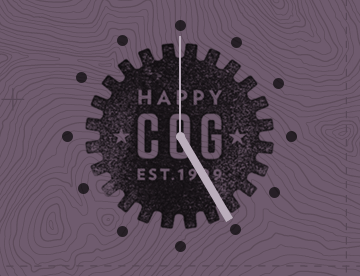
Coglaboration
Like many agencies, Happy Cog works with strategic partners and freelance professionals to supplement resources or to utilize their unique skills for internal or external project work. Finding people you can trust is not always easy.
We’ve written 43 blog posts about Team. View all topics »

Like many agencies, Happy Cog works with strategic partners and freelance professionals to supplement resources or to utilize their unique skills for internal or external project work. Finding people you can trust is not always easy.

This week’s Cognition article is brought to you by two fantastic interns here at Happy Cog, Chelsea Myers & Courtney Sabo.

The holiday break is one stretch of time during the year when I completely remove myself from the business of building the web. Stepping outside our community to engage with old friends and family members provides a much-needed recharge and change of perspective.

2014 has been a year of big change for Happy Cog. We’ve had more than a year’s worth of adventures packed into a short 12 months. One thing that remains a constant, however, is our team’s continual quest to explore and hone our roles; process; project structure; and approach to clients, partners, and coworkers. Cognition serves as our way of documenting and sharing our thoughts and discoveries with the world.

The ability to communicate well with non-technical people is what separates star developers from the rest. Star developers understand that other team members don’t need to know about implementation details. They’ve developed an understanding of the non-technical aspects of project work—things like requirements, risk, scope, client concerns, project timelines. They handle more than just the technical parts of a project with ease.
It’s no secret that most developers have room to grow in the communication department. Even within the development world, back-end developers and front-end developers’ communication skills can range. We have a hard enough time communicating with each other about things like CMS implementation, template integration, CSS best practices… and we speak each other’s lingo! Forget about trying to explain things to non-technical folks. (By the way, you may know Happy Cog only for exceptional designers and front-end devs, but it’s worth mentioning we have a brilliant back-end development team too.)

Interns can make your life as an employer a little bit easier. They are the extra pair of hands you’ve always needed, and unbridled creativity fills their minds. Interns strive to be a valuable asset to your team and want an educational and enjoyable experience. Since they are only around for a few months, making the best use of both their and your time should be a common goal. Great interns put in 110% effort every day, but what can you, the employer, do to ensure that internships are valuable for both of you?

“What’s in a name? that which we call a rose / By any other name would smell as sweet; / So Romeo would, were he not Romeo call’d” (Shakespeare, Romeo & Juliet, 2.2).
In the world of project management, naming conventions are often the source of miscommunication. You have to call your work something, but if you assume everyone interprets a name the way you intended, you’re likely to stub your toe during the course of the project. As managers, minimizing risk and setting expectations is an everyday task, yet something as simple as a name or label can fly under our radar. We live and breathe our work, and we are passionate about it. It’s a good practice to never assume labels are understood out of the gate. Here’s a few tactics to help you make naming conventions work for you.

It’s easy to get caught up in the daily grind of researching and strategizing wonderfully thought out websites. Sometimes, it’s nice to cut loose and create things just for fun, away from the computer screen. Thus, our monthly Happy Cog Handcrafted Challenge (HCHC) was born.
February was its inaugural month, and I led the effort. I wanted to take things back to elementary school and do an anonymous valentine exchange (though, I used the term “valentine” loosely—really just any card stuffed in an envelope would do).

It’s been a memorable year for us at Happy Cog. 2012 was big, but 2013 was even bigger, so we’re taking some time to reflect—both in our offices and here on Cognition.
We welcomed 14 new people this year, making Happy Cog the largest group of talented, fun-loving folks it’s ever been. Some highlights from this year: launching websites for AMC Theatres, Black Hills Corporation (and its trio of utility sites), Yale School of Management, Harvard Business School, and Longwood Gardens; working with Iron Chef Jose Garces’ team to create a design system for its restaurant websites—and breaking into an industry we’ve been a fan of for quite some time; working with our friends at MTV on our third O Music Awards site and celebration; and collaborating with talented folks at Crush & Lovely to create a video about our work with Ben & Jerry’s.

Ever since Jeffrey Zeldman founded Happy Cog in 1999, educating our industry has been a cornerstone of the company. Taking Your Talent to the Web, Designing With Web Standards, and A List Apart started this heritage, and over the years, Jeffrey has continued it with An Event Apart and the A Book Apart series. Happy Cog practitioners have built upon this foundation by teaching, speaking, and writing about web design.
Copyright 1995-2025 Happy Cog™